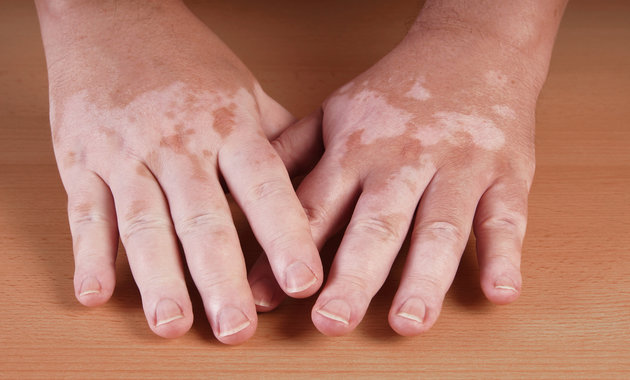The World Vitiligo Day is observed on 25th June every year with an aim to build awareness about the condition.
Vitiligo is a skin disease which is characterised by the stark presence of white patches on the skin. This happens because in vitiligo, the pigment-producing cells, known as melanocytes, are destroyed in certain areas. The patchy depigmentation of the skin is responsible for the stigma that negatively affects patients’ self-esteem and quality of life. According to 2018 study[1], it is estimated to affect about 0.5% of the population worldwide, whereas the prevalence in India is around 1.13%.
This World Vitiligo Day, let’s understand the causes, symptoms and treatment of the condition in detail and spread awareness about it.
Causes And Risk Factors Of Vitiligo
The exact cause of Vitiligo is not yet known. However, there are several factors which may play a role.
-Most experts hold the view that vitiligo could be an autoimmune disease whereby the body ‘s immune system attacks its own cells (melanocytes in this case) and results in considerable depigmentation on skin in the affected area.
-Some studies suggest that vitiligo could also have a genetic component and a person can have higher chances of getting vitiligo if it runs in the family. While vitiligo affects ~1% of the general population, the risk of a patient’s sibling developing the disease is 6%. However, in the case of an identical twin, the risk increases to around 23%[2].
The disease affects both genders equally and can appear at any age. However, the average age of onset varies based on the geographical location, which is around 22 years in India and the US[1]. Patients with vitiligo and their relatives have an increased risk of developing autoimmune diseases such as autoimmune thyroiditis, type 1 diabetes, pernicious anemia, and Addison’s disease.
*Consult India’s best doctors here**
Symptoms of Vitiligo
The symptoms of vitiligo develop gradually but are usually visible as the person is able to identify the patches of skin where it is considerably lighter than the rest of the areas. It is not necessary that the condition spreads throughout the body. Vitiligo could remain localised in a particular area of the body as well.
– The most obvious symptom of vitiligo is the white spots or patches on the skin. Such patches are mostly seen in those parts of the body which receive sun exposure.
– It is characterized by white spots typically first noted on the fingers, knuckles, around the eyes and mouth, and on the feet and genitalia.
– People suffering from vitiligo may also experience greying of hair and light patches inside the mouth or nostrils. Vitiligo is painless and is not contagious in any way.
– Vitiligo is a skin disorder that doesn’t spread from one person to another through close contact. Unlike leprosy, it is a painless condition and is not contagious in any way.
Treatment of Vitiligo
-There is no sure shot cure for vitiligo in conventional medicine. Hence the main aim of the treatment becomes improving the skin condition by trying to enhance the skin tone and pigmentation..
-The medications prescribed could be oral or in the form of ointments to protect the skin from sun radiation.
-Medicines include steroids, a form of Vitamin D, either as topical creams or systemic medications that dampen the cellular immune response, thereby aiding in reducing the inflammatory response.
-Your doctor can also suggest re-pigmentation of the affected skin using UV light therapy or lightening the skin in unaffected areas.
-Surgical options include skin grafting, blister grafting, and micro-pigmentation are also considered to be an option to improve skin tone.
Buy best Vitamin and Mineral Supplements at 1mg at affordable price
Home Care & Management
In addition to medications, there are various dietary and lifestyle changes that will help you manage vitiligo effectively.
Diet: Experts and dermatologists suggest that certain nutritional deficiencies can worsen vitiligo. This is why it is suggested that one must include foods rich in Vitamin B-12 in their diet. Its deficiency increases the level of homocysteine which can cause damage to the pigment-producing cells in the skin. Foods containing Vitamin C (kiwis, strawberries, oranges, amla) can also help to promote cell repair and cell production.
Skincare: Make sure your skin is well protected from the harmful rays of the sun. Use ample amounts of sunblock lotions on your skin and especially the affected areas. Apply sunscreens at least 15 minutes prior to stepping out in the sun. Use umbrellas, hats or more clothing to avoid direct contact of sun rays with the skin.
Home remedies: The good old kitchen remedy of applying a mixture of mustard oil and turmeric is quite popular for the treatment of vitiligo. This mixture needs to be washed after 15 to 20 minutes. Coconut oil is also used as a natural remedy to reduce the skin patches and aid re-pigmentation.
Recommended Reads:
Know Your Doctor: Skin Specialist
Oral Corticosteroids: Dos And Don’ts To Follow
References:
1. Tarlé RG, Nascimento LM, Mira MT, Castro CC. Vitiligo–part 1. An Bras Dermatol. 2014 May-Jun;89(3):461-70. https://www.ncbi.nlm.nih.gov/pmc/articles/PMC4056705/
2. Rashighi M, Harris JE. Vitiligo Pathogenesis and Emerging Treatments. Dermatol Clin. 2017 Apr;35(2):257-265. https://www.ncbi.nlm.nih.gov/pmc/articles/PMC5362109/
3. Nordlund JJ. Vitiligo: a review of some facts lesser known about depigmentation. Indian J Dermatol. 2011 Mar;56(2):180-9. https://www.ncbi.nlm.nih.gov/pmc/articles/PMC3108518/
4. Dillon AB, Sideris A, Hadi A, Elbuluk N. Advances in Vitiligo: An Update on Medical and Surgical Treatments. J Clin Aesthet Dermatol. 2017 Jan;10(1):15-28. Epub 2017 Jan 1. https://www.ncbi.nlm.nih.gov/pmc/articles/PMC5300730/
